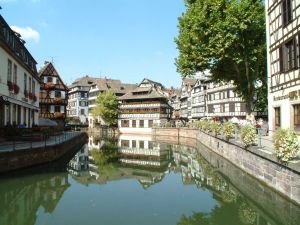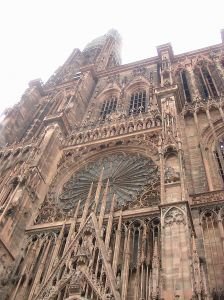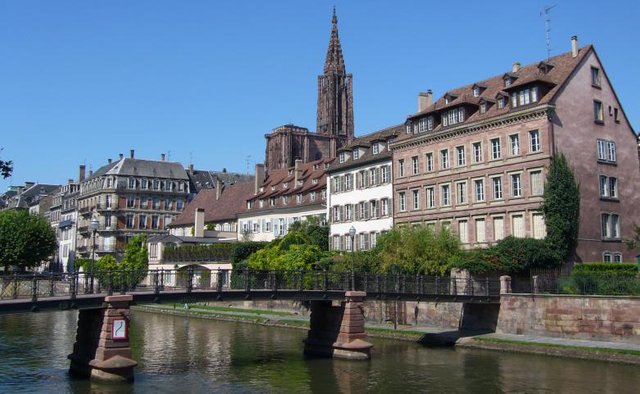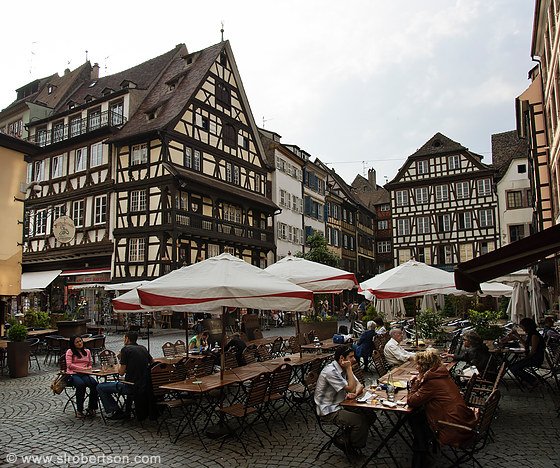Visiting Strasbourg In the Springtime
Springtime in France is a wonderful thing. The days last longer, the cities seem brighter, the vineyard-covered hill are again covered in green and the calendar of events, relatively empty of excitement during the dreary days of winter, begins to fill up with excitement. This is the season when both the locals and international visitors start to fill up the hotels
and streets of the cities, enjoying the lengthening days, 
the food and all that being in France means.
As more and more visitors start pouring into the
better known parts of France however, and you
start feeling the need for a short city break, you
may want to consider a holiday destination a little
bit off the beaten tourist track – the northern city
of Strasbourg, in the north-eastern Alsace region.
Strasbourg’s Franco-German Heritage
The north-east of France is little known as a tourist destination, but if you’re looking for a short holiday getaway with a difference, it’s a good place to explore. The Alsace region is filled with history, but it is better known for its beauty, with wide stretches of undulating countryside, charming medieval villages and large tracts of forests which inevitably draw comparisons with the Black Forest in Germany. Through this beautiful landscape flows the Ill River, and where the river flows into the Rhine on the border with Germany, sits the city of Strasbourg.
As the city’s Germanic name (which translates as "town at the crossing of roads”) indicates, the city has always been on a crossroads, in more ways than one. For centuries, it was not only one of the most important ports in the country, it was also one of the most contested, often fought over by the the various French and German powers. The city has changed hands almost a dozen times, and one of the legacies of its constantly warring past is a unique cultural heritage, which have given the people of Alsace, among other things, a unique language, a deliciously Franco-German cuisine and
a strong pride in its traditions, which are often far more German than French.

Today, though the battles for possession have ceased, Strasbourg is still one of the most ‘internationally-focused’ cities in the country, as it is the seat of the Council of Europe and the European Court of Human Rights, as well as the host of a seat of the European Parliament, together with Brussels.Because of this, the city is far better known to government officials and political journalists than it is to tourists – which isn’t necessarily a bad thing! Even during the summer season, when tourists flood the rest of the country, Strasbourg is still relatively crowd-free and pleasant.
For visitors, another attractive aspect of a trip to Strasbourg is how easy it is to get around.
For those who prefer pedal power, the city centre is very flat, with plenty of bike paths; bikes are easily available at the shop in rue du Maire Kuss, in front of the train station, or rue des Bouchers,
on the south bank of the Ill river, near the Porte de l'Hôpital tramway station. You can also take
a water-bus tour along the Ill, which stars near the Palais Rohan and runs for about 45 mins around the town centre and the European district. Of course, it’s cheaper still to walk, and its easier to stop and take photographs! There’s also a good tram and bus network available, for a quick tour. If you like to follow a route, the Strasbourg Tourist office can recommend a variety of tours around the historic centre, depending on what you see.
Strasbourg – A Beautiful City
Like many ancient cities founded on the banks of river, the historic centre of Strasbourg is sited
on the river’s banks and on an island in the middle of the waters. Strasbourg’s historic centre is
noted for its beauty, especially amongst architecture enthusiasts. Though there are now many modern (and bland) brick houses in Strasbourg, the city is known for having an unusually large number of buildings preserved from the past centuries (a notable achievement for a European city). Many of the European Union institutions are housed in majestic palaces and villas in the Quarter Europeen; for example the European Court of Human Rights is located in an enormous palace. Possibly less imposing, but arguably far more beautiful, are the palaces and villas of former noblemen and merchant princes, which are scattered around the town. Palais Rohan, former residence of the prince-bishops and now home to no less than three museums, is famed for its opulent French Baroque style, while the current Chambre de Commerce et d'Industrie is known for its German Renaissance façade. Strasbourg’s Cathedral also deserves a special mention, as it is one of Europe's most beautiful examples of Gothic architecture, with a stunning pink sandstone facade that is especially breathtaking, especially when the setting sun sets the walls aglow.

As Strasbourg was as much in the hands of the Germans as it was in the French's, you can spot German architectural styles as often as you can French. In fact, a history student with a good eye could probably chart the ebb and flow of the city’s history just from studying the buildings, if they
had the time and patience!). Even UNESCO recognizes
the city’s remarkable beauty – in 1988, the entire historic centre of Strasbourg, known as the Grand Ile or Great Island, was classified as a World Heritage Site, the first time an entire city centre received such recognition.
Even for those who can’t tell Moderne from Gothic, Strasbourg is a charming place, especially for fairy-tale lovers. Walking around some parts of Strasbourg’s centre, you may be forgiven for thinking you’d unknowingly stumbled onto the real-life set of Disney's Beauty and the Beast – all around you are cobble-stoned streets and half-timbered houses, like a scene from of a children’s book.
One of the most picturesque districts is Petite France,
a romantic quarter of narrow streets and narrow houses overlooking the banks of the Ill, which was once home to
the city's millers, tanners and fishermen. Spring is one of
the best times to visit Petite France, as the flowerboxes adorning each house burst into bloom, adding even more colour - and scents - to the area. Incidentally, the district’s charming name has a somewhat less charming origin: in the 16th century, when the town was under the (German) Alsatians, the area housed a venereal-disease hospital. The locals blamed the French for the spread of such decides, and nicknamed the quarter Zum Franz, or little France in French. The name stuck, though fortunately the hospital no longer exists.
Though Petite France is probably the most famous photo-friendly district in Strasbourg, it isn’t the
only quaint part of town. On the south side of the Pont du Corbeau, downstream from the medieval Impasse du Corbeau (which looks as though it was transplanted whole from the fourteenth century)visitors can wander around the Quai des Bateliers (Boatmen’s Quay). This area once housed merchants and tradesmen, whose livelihoods depended on the river Ill and the trading it permitted with Strasbourg’s sister city Kehl, located just across the Rhine, and it is yet more evidence of Strasbourg’s history as a crossroad between France and its Germanic neighbours to the east. History aside however, the Quai des Bateliers is best known for its postcard pretty scenes and on late spring afternoons, when the sunlight glints off the canal waters and reflects the shadows of the pastel-coloured houses, the area is utterly enchanting.
Food, Drink and Dessert
Many of the historic building on the Quai De Bataliers have been converted to restaurants, which neatly brings us to the next topic of interest to a visitor: food. The contrasts and similarities between the culture and tradition of Alsace and its French and German neighbours is best exemplified in its cuisine, which happily means that simply eating out can be a cultural experience!

Strasbourg is right smack on the dividing line between the German the French , and it happily caters to both crowds. The Alsace region is one of the major producing regions in France and offers some of the world’s most noted dry Rieslings. The countryside surrounding Strasbourg is covered with vineyards and there is a Route des Vines, or Route, which meanders among the grape-covered hillsides. One of the most popular activities in Strasbourg is to take a drive or bicycle tour along the Route des Vines and in springtime, when the vines are beginning to bud tiny green grapes, visitors can see vineyard workers out in the fields busily tending the precious vines. Interspersed between the vineyards are huge fields of hops, which feed the brewery vats of such major as Kronenbourg, Fischer, Heineken, Météor, and Kanterbräu; for an easy first hand look at the industry, you can visit the Kronenbourg and Fischer factories, where you’ll get a tour of the facilities – and free drinks at the end of the tour!
There is no more traditional place to eat in Strasbourg than the winstub, or restaurant, where everyone sits together at large wooden tables covered with red-checkered tableclothes. Originally built as rooms for owners and producers to sell off their surplus production, they are now as much a focal point of Alsace culture as the pub is to the English culture, or to the German. Once seated in a winstub, the choices are varied, tasty and hearty (no dainty Parisian portions here!). Alsatian cuisine offers some refined, high-culture dishes, such as its famous foie gras, or succulent pike-perch, and it has a surprising number of tarts (the kougelhopf is a regional tradition), but the definitive dish of the Alsace region is the choucroute, the local version of the German dish sauerkraut. Many of the restaurants in Strasbourg will serve this dish (with greater or lesser amount of innovation, depending on the chef’s tastes); some of the recommended restaurants are Julien (22 quai des Bateliers), Buerehiesel (4 parc de l'Orangerie) and au Crocodile (10 rue de l’Outre).
Another popular dish to try is flammakuche, which is almost as much a symbol of Alsace as the choucroute. It is a type of a pizza made of white cheese, fresh cream, bacon and onions. One of
the most popular restaurants for this dish is Flam’s (29 rue des frères), which offers as many flammakuche as you can eat for EUR 11; during the summer, it’s better to book a seat before going, as it’s usually crowded. Also, in true French tradition, many restaurants offer dishes which are only available in the springtime, taking advantage of new vegetables sprouting up to whips up dishes such as Green Asparagus Feuillete with Champagne Butter (yum!).
Of course, there are many other reasons to visit Strasbourg in the springtime, or really at any time
at all. In November for instance, the centuries old Christmas market springs up and visitors come from hundreds of miles around to peruse the many, often hand made, offerings on display. Still,
if you’re looking to escape the crowds and indulge in a short city break away the more familiar
tourist major hot-spots, give Strasbourg a go – you’ll be pleasantly surprised.